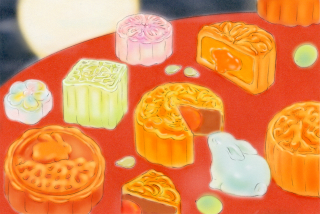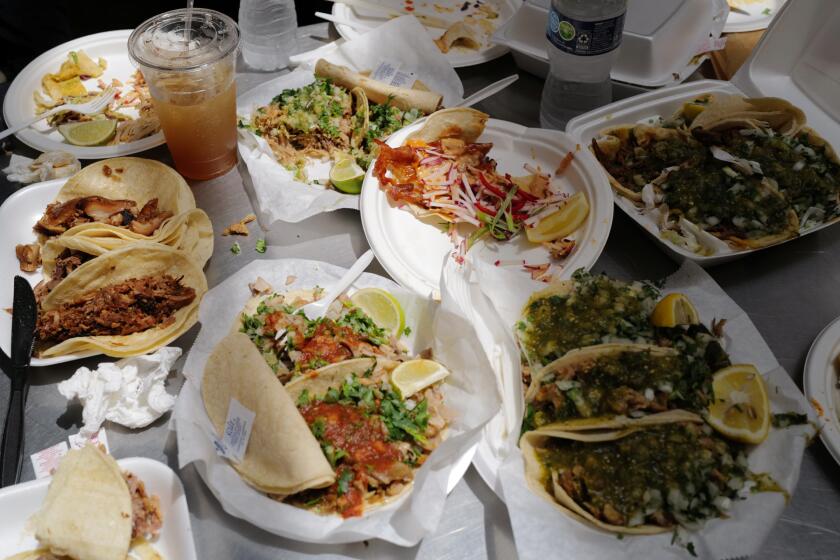At First Blush, Hard to Pick Just 1 : A List of 12 Wines Suggests Variety of Styles Available
The blush boom has produced so many wines that consumers may find it difficult to choose among them. To sample the market, The Times’ Food staff reviewed a dozen releases. These were not submitted by wineries nor recommended by wine experts but chosen at random, in most cases with no prior knowledge of how they would taste.
The 12 selected are not to be regarded as The Times’ choice of the 12 best wines, nor even as a cross section of current production. They merely suggest the variety of styles available. The wines range in place of origin from Temecula to the Napa Valley and include two from the Los Angeles area. Red wine grapes involved in their production are Zinfandel, Cabernet Sauvignon, Pinot Noir, Napa Gamay and Merlot. Some are made from a single grape; some blend two or more varietals, and some blend in white wine. Colors range from very pale through various shades of peach, salmon and pink, sometimes touched with gold. Several wines are very dry, but most are slightly sweet, or “off-dry,” as wine makers say. And many of them are slightly spritzy.
The following list of the wines is alphabetical. The prices stated are the retail prices charged at the wineries.
Ahern, 1984, San Luis Obispo County Napa Gamay Blanc, $5. A blend of 88% Napa Gamay and 12% Pinot Blanc, this wine comes from the San Fernando Valley’s only producing winery. To settle the confusion of the two place names in its title, the grape variety is called Napa Gamay, and the grapes used in the wine were grown in San Luis Obispo County. Delicately peach colored, the wine is slightly spritzy, sweet and fruity. Its flavor inspires thoughts of strawberries and watermelon. Tasters suggest serving it with Thanksgiving dinner or other holiday events and as an aperitif.
Au Bon Climat, 1984, Santa Barbara County Pinot Noir-Chardonnay, $6. A blend of 80% Pinot Noir and 20% Chardonnay, this wine was produced and bottled by Clendenen-Tolmach Vintners, Los Alamos, from grapes grown at the Los Alamos Vineyards. Jim Clendenen says the wine is totally fermented in oak barrels imported from Burgundy and is as dry and high in acid as the Au Bon Climat Chardonnays. The blend was designed to combine the body, richness and fruit flavors of the Pinot Noir with the acid and finesse of the Chardonnay grape. Clendenen says the wine is a good partner to Mexican food. Times tasters recommend it with poultry, seafood or other dishes best accompanied by a very dry wine.
Britton Cellars, 1984, Cabernet Pearl, $5. Located in Temecula, Britton Cellars opened its doors in April and has six wines, including two blushes, on its list. The Cabernet Pearl is made 100% from Cabernet Sauvignon grapes grown in the winery’s 22 acres of vineyards. Wine maker and co-owner Tom Freestone says Britton produced 600 cases of the 1984 wine and this year will triple production. Delicate peach in color, the Cabernet Pearl is off-dry and fruity, good to serve with turkey, ham, chicken with a variety of sauces, seafood and some cheeses.
Byron Vineyard & Winery, 1984, Santa Barbara County Blanc de Noir, $5. Ken Brown makes wine for both Zaca Mesa Winery at Los Olivos and Byron, which he opened Sept. 1 at Santa Maria. The Byron Blanc de Noir consists of 70% Gamay, which Brown says he adds for fresh, lively fruitiness, and 30% White Riesling, which provides sweetness and floral bouquet. The preliminary fermentation in tanks is completed in barrels. The wine is then racked and aged two months in French oak barrels. Distribution is mainly in San Luis Obispo, Santa Barbara and Ventura counties, with limited availability in Los Angeles. Tasters recommend this wine with appetizers, pasta salad, chicken, fish and fruit.
J. Carey, 1983, Santa Ynez Valley Cabernet Blanc. The 1984 and 1985 vintages are $5.75 at the winery. The 1983 was $4.23 at a wine and liquor store. This 100% Cabernet Sauvignon wine is made from grapes grown in the winery’s eight-acre Alamo Pintado Vineyard, located just outside Solvang. According to wine maker Scott Meyer, this vineyard yields grapes that tend to lack color and provide fruitier, more herbaceous qualities than he desires in a red Cabernet. It will eventually be grafted over to other varieties. The wine is fairly dry and has an interesting “grassy” overtone that makes it a good companion to food that is distinctively flavored.
R. & J. Cook, 1983, Merlot Blanc, $5.25. Roger and Joanne Cook, whose winery is in the Sacramento Delta, put different varieties of red grapes in plastic bags, squashed them, then smelled and tasted the results. “There was something in the Merlot that we liked better,” Joanne Cook said. And that was the origin of this wine, which was introduced in 1980. According to Cook, the 1983 vintage contains a drop of Orange Muscat, and the 1984 is blended with 20% Chenin Blanc. The wine is sweet, with a hint of honey that makes it suitable with light dishes and sweet sauces, but not with roasts or steaks.
De Loach Vineyards, 1984, Russian River Valley White Zinfandel, $5.75. Former San Francisco firefighter Cecil de Loach is now a Sonoma grape grower and wine maker. His 100% Zinfandel wine is made from grapes that are picked at full maturity. They are then cold-fermented to retain maximum fruit flavor. The wine has a marked pink color, pleasant spritziness, fruity aroma and flavor. Sweet but crisp, it is suitable for summer picnics and patio parties and, in winter, as a ski wine. Try it also with ham or turkey or as an aperitif.
Mill Creek Vineyards, 1984, Estate Bottled Cabernet Blush, $5. A rosy, strawberry-like color and fruity aroma characterize this 100% Cabernet Sauvignon wine from vineyards in Healdsburg, Sonoma County. Off-dry and spritzy, the wine is nice for picnic lunches. “It’s best on a Sunday afternoon,” winery co-owner Bill Kreck said. Try it also with hot duck salad, Danish roast pork stuffed with prunes, and other light meat and poultry dishes. Introduced with the vintage of 1976, this is the wine that initiated and trademarked the word blush.
R. Montali Winery, 1982, Bel Blanc Blanc de Noir, $4. This wine is a blend of 75% Zinfandel, 20% Pinot Noir and 5% Cabernet Sauvignon. Whereas most blush wines should be drunk within a year or so, Ralph Montali says this one is made so that it can be aged. The winery, located at Berkeley, has a press that takes the grape juice off the skins in 30 seconds. In that short time, the Blanc de Noir acquires a light but strong peach color. Sweet and without spritziness, the wine goes well with lighter meats, chicken curry and other Oriental dishes.
San Antonio Winery, 1983, California Barbera Blanc, $3.50. Santo Riboli of this downtown Los Angeles winery says Barbera is a tangy variety that has good color when picked early. The grapes for this 100% Barbera wine come from San Antonio’s Fresno vineyards. Once called Light Barbera, it is being renamed White Barbera with the 1985 vintage to make it more identifiable to the consumer. Tasters liked this wine for its attractive light blush and fruity, full, sweet flavor. They suggest it as a brunch wine or a companion to fruit salads, chicken or spicy dishes such as Mexican mole.
Sutter Home Winery, 1984, White Zinfandel, $4.50. Very pale in color, the wine is decidedly sweet but balanced with high acid. The light color and acidity result in part from picking the grapes early when the sugar content is lower and the full color is not in the skins. The wine is not made 100% from Zinfandel grapes but is “well above” the legal requirement of 75% for a varietal wine, according to Steve Bertolucci, the wine maker. Sutter Home won’t divulge the exact composition, but some tasters detected a Muscat aroma and flavor. They found the wine light, fresh and pleasant. Its sweetness suggested dessert to some. Others said they would serve it with appetizers, fish, poultry and cheeses.
Weibel Vineyards, 1984, Mendocino County White Pinot Noir, $4.50. According to vice president and wine maker Rick Casqueiro, Mendocino County grapes are known for their high fruit acids. Made 100% from Pinot Noir grapes grown in that area, this wine is drier than many blushes, and is crisp and prickly with spritziness. Pale salmon in color, it makes a clean background to fish, seafood casseroles, chicken with mustard sauce and other foods that require a less sweet wine.
More to Read
Eat your way across L.A.
Get our weekly Tasting Notes newsletter for reviews, news and more.
You may occasionally receive promotional content from the Los Angeles Times.








